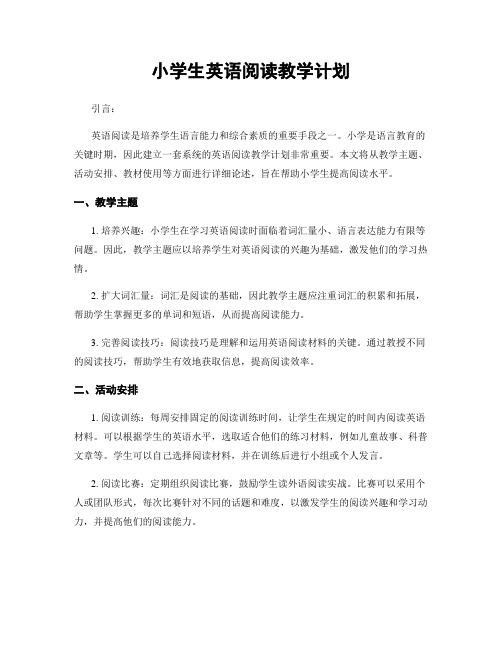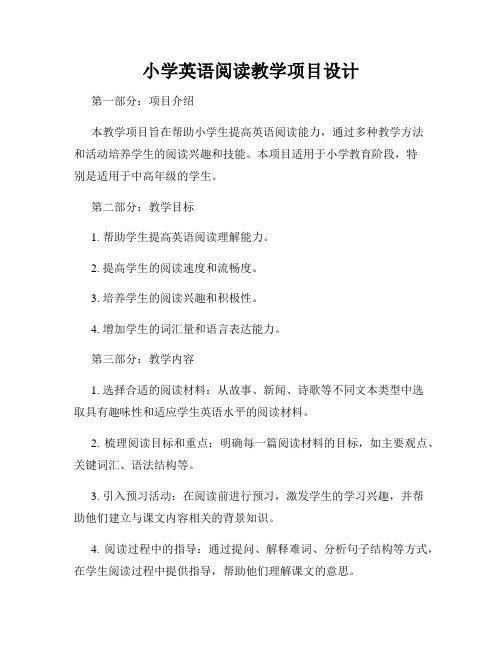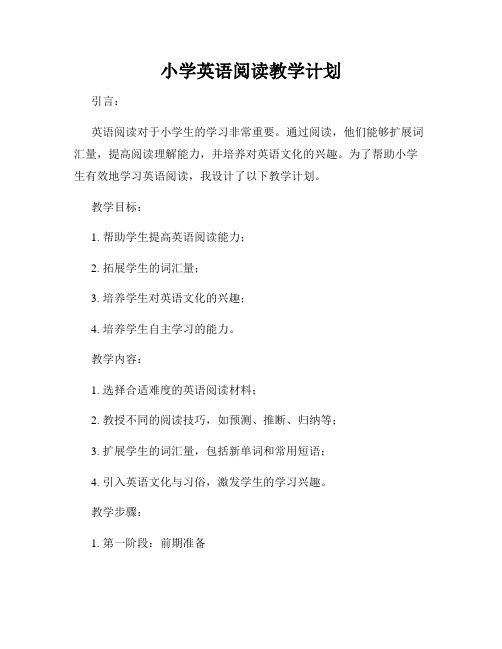小学英语阅读教学课题计划(完整资料).doc
小学生英语阅读教学计划

单击此处添加副标题
汇报人:XXX
目录
CONTENTS
Part One
阅读教学目标
Part Two
阅读教学内容
Part Three
阅读教学安排
Part Four
阅读教学活动
Part Five
阅读教学资源
01
阅读教学目标
培养阅读兴趣
激发学生阅读英语的兴趣,提 高学习积极性。
设计多样化的练习形式,如选择题、填空题、问答题等,以检验学生的 阅读理解能力。
安排适当的阅读材料,让学生进行阅读练习,巩固所学知识。
及时反馈学生的练习结果,指导学生进行有针对性的复习和补充学习。
结合学生的实际情况,设计不同层次的练习题目,满足不同水平学生的 需求。
03
阅读教学安排
课时安排
每周安排2个课时进行英语阅读教学 每个课时40分钟 确保每节课有充足的时间让学生阅读和讨论 根据学生的实际情况和教学进度灵活调整课时安排
鼓励家长参与孩子的英语阅读, 提供家庭阅读资源
建立家长志愿者团队,协助学 校开展阅读活动
添加标题
添加标题
添加标题
添加标题
定期开展家长培训,提高家长 的教育理念和方法
鼓励家长与孩子共同阅读,培 养家庭阅读氛围
THANK YOU
汇报人:XXX
阅读竞赛:组织学生进行阅读比赛,评选出阅读速度最快、理解最准确的学生,激发阅读积极 性。
故事接龙:学生依次讲述故事的一部分,形成接力赛的形式,提高阅读表达和逻辑思维能力。
阅读延伸活动
角色扮演:让 学生扮演故事 中的角色,用 英语进行对话 和表演
故事续写:让 学生根据故事 情节进行创意 续写,培养想 象力和写作能 力
小学生英语阅读教学计划

小学生英语阅读教学计划引言:英语阅读是培养学生语言能力和综合素质的重要手段之一。
小学是语言教育的关键时期,因此建立一套系统的英语阅读教学计划非常重要。
本文将从教学主题、活动安排、教材使用等方面进行详细论述,旨在帮助小学生提高阅读水平。
一、教学主题1. 培养兴趣:小学生在学习英语阅读时面临着词汇量小、语言表达能力有限等问题。
因此,教学主题应以培养学生对英语阅读的兴趣为基础,激发他们的学习热情。
2. 扩大词汇量:词汇是阅读的基础,因此教学主题应注重词汇的积累和拓展,帮助学生掌握更多的单词和短语,从而提高阅读能力。
3. 完善阅读技巧:阅读技巧是理解和运用英语阅读材料的关键。
通过教授不同的阅读技巧,帮助学生有效地获取信息,提高阅读效率。
二、活动安排1. 阅读训练:每周安排固定的阅读训练时间,让学生在规定的时间内阅读英语材料。
可以根据学生的英语水平,选取适合他们的练习材料,例如儿童故事、科普文章等。
学生可以自己选择阅读材料,并在训练后进行小组或个人发言。
2. 阅读比赛:定期组织阅读比赛,鼓励学生读外语阅读实战。
比赛可以采用个人或团队形式,每次比赛针对不同的话题和难度,以激发学生的阅读兴趣和学习动力,并提高他们的阅读能力。
3. 读书会:安排每月一次的读书会,让学生自愿阅读英语书籍,并分享他们的阅读体验。
学生可以通过演讲、讨论或写作的方式展示自己对书籍的理解和感受,既丰富了英语阅读的内容,又增强了学生的表达能力。
三、教材使用1. 综合教材:选用一套优秀的综合教材作为教学主要参考,例如《小学英语教程》等。
教材应根据学生的年龄特点和学习需求,设计有趣且贴近实际生活的阅读材料,以吸引学生的兴趣。
2. 分级读物:借助分级读物,如《牛津英语阅读书籍》等,根据学生的英语水平提供相应难度的阅读材料。
分级读物将阅读内容按照难易程度划分,帮助学生逐渐适应和提高阅读能力。
3. 多媒体资源:利用多媒体资源,例如英语学习软件、动画和音频,增加教学的趣味性和生动性。
小学英语阅读教学项目设计

小学英语阅读教学项目设计第一部分:项目介绍本教学项目旨在帮助小学生提高英语阅读能力,通过多种教学方法和活动培养学生的阅读兴趣和技能。
本项目适用于小学教育阶段,特别是适用于中高年级的学生。
第二部分:教学目标1. 帮助学生提高英语阅读理解能力。
2. 提高学生的阅读速度和流畅度。
3. 培养学生的阅读兴趣和积极性。
4. 增加学生的词汇量和语言表达能力。
第三部分:教学内容1. 选择合适的阅读材料:从故事、新闻、诗歌等不同文本类型中选取具有趣味性和适应学生英语水平的阅读材料。
2. 梳理阅读目标和重点:明确每一篇阅读材料的目标,如主要观点、关键词汇、语法结构等。
3. 引入预习活动:在阅读前进行预习,激发学生的学习兴趣,并帮助他们建立与课文内容相关的背景知识。
4. 阅读过程中的指导:通过提问、解释难词、分析句子结构等方式,在学生阅读过程中提供指导,帮助他们理解课文的意思。
5. 后阅读活动:设计与课文相关的练习,如填空、选择题、判断题等,以检测学生的阅读理解能力。
第四部分:教学方法1. 小组合作学习:组织学生进行小组合作学习,通过互相讨论和合作完成阅读任务。
2. 图文搭配:结合图片、图表等视觉辅助材料,帮助学生更好地理解阅读内容。
3. 视听辅助:使用多媒体设备,播放英语原声、视频等,提供真实语境和音频视觉输入,增加学生的听说能力。
4. 游戏化学习:结合游戏元素,设计阅读游戏,引导学生主动参与,增加学习的趣味性和动力。
第五部分:教学评价1. 阅读理解测试:定期对学生进行阅读理解测试,检测学生的阅读能力和学习效果。
2. 口头表达评估:通过学生口头回答问题、讲述故事等方式,评估学生的语言表达能力和理解能力。
3. 书面作业检查:检查学生的书面作业,包括填空题、选择题、翻译等,评估学生的书面理解和语言应用能力。
第六部分:教学资源1. 阅读材料:收集适合不同年级学生的英语阅读材料,包括故事书、英语读物、报纸文章等。
2. 多媒体设备:准备多媒体设备,用于播放英语原声、视频等辅助学习材料。
《小学英语阅读教学探究》课题计划

《小学英语阅读教课研究》课题计划小学英语教课的主要目的是培育学生学习英语的兴趣和初步的英语语感,使其形成正确的语音、语调,初步具备运用所学英语进行社交的能力。
阅读作为语言学习的一个重要手段,它既能够扩大学生的词汇量,又能够使学生在阅读过程中认识英美等国的文化背景、生活风俗、思想习惯及英语语言的特色。
指引学生参加、体验英语阅读的乐趣,激发学生阅读的兴趣,培育学生优秀的学习习惯和有效的学习策略,培育学生综合语言运用能力,这正是新课标所倡导的。
一、课题研究的背景小学阶段只需修业生读懂一些简略的读物,难度不大,但作为开端阶段,方法的掌握、习惯的形成倒是特别重要的。
依照小学生学习语言的规律,培育拼读能力十分重要。
在平时教课中,很多学生,特别是中低段学生对掌握单词的拼读广泛感觉困难,所以教师应注意培育学生养成正确的学习方法,如在实质教课中可采纳江苏溧阳实验小学实行的“直接拼音法” 。
这是一种按字母或字母组合的读音规则拼读和拼写单词的方法,它既能够内化学生的认知构造,又能够培育学生见词能读音和听音能写词的能力,同时还可以够防备学存亡记硬背等坏习惯的形成。
其次,培育学生形成优秀的朗诵方法和习惯是特别重要的。
中高段的学生对语音是比较敏感的,一旦读得禁止,形成习惯,改起来是有必定难度的。
所以,应在实质教课中尽量使用标准的录音,让学生模拟,以培育学生形成标准地道的语音、语调。
而后教师能够再辅以朗诵技巧的解说,让学生在存心义的语流中掌握标准的语音、语调、重音、意群与节奏。
再次,培育学生形成优秀的阅读方法和习惯也是特别重要的。
很多高段的学生都有一些不良的阅读习惯和阅读方法,如:阅读时唇动和低声读、用手指着所读内容、不停回读、脑袋摇动等,这些都直接影响阅读速度,从而影响阅读成效。
所以,在实质教课中,教师应第一经过题目、图示、上下文以及构词法等,培育学生猜想生词的能力。
其次帮助学生掌握抓要点词的能力。
如在阅读时,注意事物 (what)、地址 (where)、人物 (who)、时间 (when)、如何 (how)、原由 (why) 等要点词。
小学四年级英语阅读教学计划

小学四年级英语阅读教学计划一、教学目标本教学计划旨在帮助小学四年级学生提高英语阅读能力,包括词汇理解、句子理解和篇章理解。
二、教学内容1. 词汇理解:教授常用词汇,引导学生掌握词汇的发音和词义。
2. 句子理解:通过阅读简单句子和短文,让学生理解句子的结构和意思。
3. 篇章理解:逐步引导学生阅读简单的篇章,培养他们的阅读理解能力。
三、教学方法1. 听力训练:通过听录音,学生跟读和理解句子和篇章。
2. 分级阅读:根据学生的阅读能力,选择适合他们的阅读材料,逐渐提高难度。
3. 写作练:让学生通过写作练,巩固所学的词汇、句子和篇章。
四、教学步骤1. 第一阶段:词汇理解- 研究常见的英语单词,并进行发音练。
- 通过图片和例句,引导学生理解单词的意思和用法。
2. 第二阶段:句子理解- 给学生提供简单的句子,让他们通过理解句子的语法和词汇,把句子翻译成汉语。
- 引导学生进行句子理解的交流,提高他们的口语表达能力。
3. 第三阶段:篇章理解- 给学生提供简单的短文和故事,让他们通过阅读理解故事的主要内容和细节。
- 引导学生进行篇章理解的讨论,提高他们的阅读理解能力。
4. 第四阶段:总结和复- 对所学的词汇、句子和篇章进行总结和复。
- 给学生提供相关的练题,检查他们的阅读理解能力。
五、教学评估1. 日常评估:通过课堂练、口头回答问题等方式,检查学生的研究进度。
2. 定期考试:安排定期考试,评估学生的阅读理解能力和研究成果。
六、教学资源1. 教材:选择适合四年级学生的英语教材和阅读材料。
2. 录音:为学生提供听力训练的录音素材。
3. 图片和图片书:用于词汇教学和句子理解的辅助工具。
通过本教学计划,我们希望能够培养小学四年级学生的英语阅读能力,为他们打下坚实的英语基础。
小学英语阅读教案计划

小学英语阅读教案计划课时:1课时年级:小学四年级教学目标:1. 能正确朗读课文,理解课文大意。
2. 能运用所学词汇和句型进行简单的交流。
3. 培养学生的阅读兴趣,提高阅读能力。
4. 引导学生学会关爱动物,与动物和谐相处。
教学内容:1. 课文:《The Cat and the Mouse》2. 词汇:cat, mouse, run, chase, hole, hide等。
3. 句型:What's this? It's a/an... How old is it? It's... years old.教学过程:Step 1: Lead-in(5分钟)1. 教师展示一张猫和老鼠的图片,引导学生说出它们的英文名称。
2. 教师询问学生是否知道猫和老鼠的特点,引导学生用英语进行回答。
Step 2: Pre-reading(5分钟)1. 教师给出课文标题《The Cat and the Mouse》,引导学生猜测课文内容。
2. 教师快速浏览课文,引导学生关注关键词汇。
Step 3: While-reading(10分钟)1. 教师引导学生跟随课文朗读,注意语音语调。
2. 教师暂停课文,针对关键词汇进行讲解和练习。
3. 教师引导学生回答课文内容相关问题,检查学生对课文的理解。
Step 4: Post-reading(10分钟)1. 教师组织学生进行角色扮演,表演课文故事。
2. 教师引导学生运用所学词汇和句型进行小组交流,讨论自己喜欢的动物。
Step 5: Summary(5分钟)1. 教师引导学生总结本节课所学内容。
2. 教师强调关爱动物,与动物和谐相处的重要性。
Step 6: Homework(5分钟)1. 学生回家后,和家长一起寻找其他关于猫和老鼠的故事,分享给家长。
2. 学生和家长一起完成课后练习题。
教学评价:1. 课后收集学生的角色扮演视频,观察学生的口语表达和表演能力。
2. 检查课后练习题完成情况,了解学生的学习效果。
小学英语阅读教学计划

小学英语阅读教学计划引言:英语阅读对于小学生的学习非常重要。
通过阅读,他们能够扩展词汇量,提高阅读理解能力,并培养对英语文化的兴趣。
为了帮助小学生有效地学习英语阅读,我设计了以下教学计划。
教学目标:1. 帮助学生提高英语阅读能力;2. 拓展学生的词汇量;3. 培养学生对英语文化的兴趣;4. 培养学生自主学习的能力。
教学内容:1. 选择合适难度的英语阅读材料;2. 教授不同的阅读技巧,如预测、推断、归纳等;3. 扩展学生的词汇量,包括新单词和常用短语;4. 引入英语文化与习俗,激发学生的学习兴趣。
教学步骤:1. 第一阶段:前期准备在开始阅读教学之前,教师需要收集并准备一系列适合小学生的英语阅读材料。
材料可以包括图书、绘本、简短故事等。
确保材料的难度适中,符合学生的年龄和英语水平。
2. 第二阶段:阅读教学a. 引导学生快速浏览阅读材料,了解文章大意和结构。
教授预测技巧,让学生根据标题、插图等内容预测文章的主题。
b. 教授学生如何从上下文中推断词义,引导他们用已有的知识猜测生词的意思。
c. 教授学生找到关键信息,进行归纳总结。
引导学生进行主旨概括,找出文章中的重要细节。
d. 通过组织讨论、角色扮演等活动培养学生的表达能力和阅读理解能力。
3. 第三阶段:词汇拓展a. 在阅读材料中选择生词,对学生进行词汇讲解和示范。
b. 制作词汇卡片或使用在线学习资源,帮助学生巩固词汇记忆。
c. 利用游戏、练习等方式进行词汇复习,培养学生的记忆能力。
4. 第四阶段:英语文化引入a. 选取与阅读材料相关的英语文化知识,如节日、习俗等。
b. 通过讲解、展示图片或视频等方式引入英语文化,增加学生对英语的兴趣。
c. 鼓励学生使用所学英语表达与文化相关的内容,培养他们的跨文化交流能力。
评估方式:1. 通过日常课堂表现观察学生的阅读理解能力;2. 设计阅读理解题目进行测试;3. 考察学生使用学到的词汇和短语进行口头表达的能力;4. 观察学生参与活动的积极性和主动性。
小学英语关于阅读的课题研究计划

小学英语关于阅读的课题研究计划全文共3篇示例,供读者参考篇1Title: Research Plan on Primary School English Reading1. IntroductionReading is one of the essential skills that primary school students need to develop in order to succeed academically. In the context of English language learning, reading proficiency plays a crucial role in enhancing language understanding, vocabulary expansion, and overall language proficiency. Therefore, this research plan aims to investigate effective strategies for improving English reading skills among primary school students.2. ObjectivesThe primary objectives of this research plan are as follows:- To identify the current reading levels of primary school students in English.- To explore the challenges faced by primary school students in developing English reading skills.- To investigate effective reading strategies and activities that can be implemented in the classroom.- To assess the impact of these strategies on students' reading proficiency.3. MethodologyThis research plan will employ a mixed-methods approach, combining quantitative and qualitative research methods. The following research methods will be used:- Surveys: Surveys will be conducted to assess the reading levels of primary school students in English and to gather information on their reading habits and preferences.- Interviews: Interviews will be conducted with teachers to explore their perspectives on the challenges faced by students in developing English reading skills and to identify effective teaching strategies.- Classroom observations: Classroom observations will be carried out to observe the implementation of reading activities and strategies by teachers and to assess their impact on students' reading proficiency.- Pre- and post-tests: Pre- and post-tests will be administered to students to measure the effectiveness of the reading strategies implemented in the classroom.4. Expected OutcomesIt is expected that this research plan will yield the following outcomes:- A better understanding of the current reading levels of primary school students in English.- Identification of the challenges faced by students in developing English reading skills.- Identification of effective reading strategies and activities that can be implemented in the classroom.- Assessment of the impact of these strategies on students' reading proficiency.5. SignificanceThis research plan is significant as it will contribute to the body of knowledge on English reading instruction for primary school students. The findings of this research plan can be used to inform and improve English reading instruction in primaryschools, ultimately leading to enhanced reading proficiency among students.In conclusion, this research plan on primary school English reading aims to identify effective strategies for improving reading skills among primary school students. By investigating the current reading levels of students, exploring the challenges they face, and assessing the impact of effective reading strategies, this research plan seeks to enhance English reading instruction in primary schools and promote students' overall language proficiency.篇2Title: Research Plan on Elementary English ReadingIntroduction:Reading is one of the key skills that students need to develop in elementary school. Not only does it help students improve their language abilities, but it also broadens their knowledge and fosters critical thinking skills. In this research plan, the focus will be on exploring effective strategies and methods to enhance English reading skills among elementary school students.Research Objectives:1. To investigate the current status of English reading among elementary school students.2. To identify the challenges and difficulties that students face in English reading.3. To explore effective strategies and methods to improve English reading skills.4. To develop practical recommendations for teachers to enhance students' reading abilities.Research Methods:1. Surveys: Conduct surveys among elementary school students, teachers, and parents to gather information about students' reading habits, interests, and challenges.2. Observations: Observe students' reading behaviors in the classroom and at home to understand their reading practices.3. Interviews: Interview teachers and reading specialists to gain insights into effective reading strategies and methods.4. Literature Review: Review relevant studies and research articles on English reading instruction in elementary schools.Research Plan:1. Conduct surveys among elementary school students to gather data on their reading habits and interests.2. Observe students' reading behaviors in the classroom and at home to identify patterns and challenges.3. Interview teachers and reading specialists to learn about effective reading strategies and methods.4. Analyze the collected data and identify key findings related to students' reading abilities and challenges.5. Develop practical recommendations for teachers to improve students' reading skills based on the research findings.Expected Outcomes:1. A better understanding of the current status of English reading among elementary school students.2. Identification of key challenges and difficulties that students face in English reading.3. Effective strategies and methods to enhance students' English reading skills.4. Practical recommendations for teachers to improve students' reading abilities.Conclusion:This research plan aims to explore effective strategies and methods to enhance English reading skills among elementary school students. By conducting surveys, observations, interviews, and literature reviews, the research will provide valuable insights into students' reading habits, challenges, and effective reading instruction practices. The ultimate goal is to improve students' reading abilities and foster a love for reading in elementary schools.篇3Research ProposalTitle: Study on Reading in Elementary English EducationIntroduction:Reading is a fundamental skill that plays a crucial role in the overall development of a child. It is especially important in the field of English education as language proficiency largely depends on the ability to read and comprehend texts. This research proposal aims to explore various aspects of reading in elementary English education and identify effective strategies to enhance reading skills among young learners.Objectives:1. To investigate the current reading practices in elementary English education.2. To analyze the factors influencing reading performance in young learners.3. To explore different approaches and techniques used in teaching reading to elementary students.4. To identify effective strategies for promoting reading comprehension and fluency in young learners.5. To develop recommendations for improving reading instruction in elementary English education.Literature Review:Research on reading in elementary education has shown that early exposure to reading materials and regular reading practice can significantly improve reading skills among young learners. Additionally, studies have highlighted the importance of using a variety of reading materials, such as storybooks, poems, and informational texts, to engage students and enhance their reading comprehension. Various teaching strategies, such as guided reading, shared reading, and independent reading,have been found to be effective in promoting reading fluency and comprehension in elementary students.Methodology:This study will employ a mixed-methods approach, combining quantitative surveys and qualitative interviews to gather data on reading practices in elementary English education. Elementary school teachers and students will be invited to participate in the study, with a focus on collecting information on their reading habits, experiences, and challenges. Data analysis will involve statistical tests and thematic analysis to identify patterns and themes related to reading in elementary education.Expected Outcomes:The findings of this study are expected to provide insights into the current state of reading in elementary English education and offer recommendations for improving reading instruction for young learners. It is hoped that the research will contribute to the development of effective strategies and resources for promoting reading skills among elementary students and ultimately enhance their language proficiency and academic performance.Conclusion:Reading is a fundamental skill that plays a key role in the development of young learners. This research proposal seeks to investigate various aspects of reading in elementary English education and identify effective strategies for enhancing reading skills among elementary students. By studying current reading practices, analyzing factors influencing reading performance, and exploring different teaching approaches, this study aims to contribute to the improvement of reading instruction in elementary education and support the overall language development of young learners.。
- 1、下载文档前请自行甄别文档内容的完整性,平台不提供额外的编辑、内容补充、找答案等附加服务。
- 2、"仅部分预览"的文档,不可在线预览部分如存在完整性等问题,可反馈申请退款(可完整预览的文档不适用该条件!)。
- 3、如文档侵犯您的权益,请联系客服反馈,我们会尽快为您处理(人工客服工作时间:9:00-18:30)。
此文档下载后即可编辑
小学英语阅读能力培养的研究课题的实施方案
一、课题的提出
小学阶段开设英语课程的目的是培养学生学习英语的积极情感,形成初步的英语语感,为其打好语音、语调基础,最终使学生具备初步的用所学英语进行交流的能力。
阅读是语言学习的一个重要方面。
阅读教学在外语教学中起着十分重要的作用,长期以来在我国的英语教学中,阅读课一直是最受重视的科目。
它可以帮助学生得到乐趣,获取信息,培养学生的英语阅读理解能力,使学生养成良好的英语阅读习惯,具有正确的阅读技巧,拥有主动学习的能力和合作的精神,为终身学习打下基础。
阅读是巩固和扩大词汇量的好方法。
然而现行的小学英语并无明确的英语阅读教学目标和配套的阅读教材,因此在小学阶段开设英语阅读课具有重要的现实意义,也是时代发展的必然趋势。
二、课题的界定
基础教育阶段,《新课程标准》已较大的篇幅阐述了英语学习策略,这就对英语教师的教学策略提出了新的要求:能在实践教学中运用科学的教学策略帮助学生有效地使用学习策略,采用科学的方法提高学习效率,培养学生自主学习的能力和自身发展能力。
阅读教学策略是英语学习策略的一部分,它源于教学实践的需要,在阅读教学中根据一定的教学理论和学生的实际情况,设计出教师自己对课内外阅读教学组织和调控的方案。
三、课题研究的理论依据
古德曼(K.S.Goodman)在1972年指出:“阅读是对三种相互有关而各有区别的信息,即形符的、句法的和语义的信息,进行信息处理的一种形式。
”英语阅读包括了朗读和默读。
但主要是借助视觉进行默读。
默读是最符合实际需要的方式。
默读要求把注意点放在理解语言单位上,速度较快。
现在的中学生普遍存在阅读速度慢、理解能力弱的现象。
导致这种现象有多方面的原因,如情感因素,方法与策略因素,智力因素。
但在我的教学中,我发现其主要原因是语言因素限制了学生英语阅读能力的形成。
所谓的语言因素是指字母、单词、习语、短语和语法规则等。
当学生遇到新单词或新句式时,立即产生了畏惧感,觉得束手无策,思路混乱。
其次,学生缺乏阅读的兴趣。
大部分学生除了作业中的阅读练习,从来不主动阅读课外材料。
再者,学生对阅读的内容缺乏深层的理解。
四、课题研究的目标
(一)研究的目的:探索小学英语阅读教学的有效方法。
(二)总体目标:巩固和扩大词汇量,增强语感,提高学生的阅读速度和理解的准确度,逐步形成他们的英语阅读习惯和能力。
帮助学生善于、乐于了解异国文化,拓展实践空间,不断提高学生学习英语的兴趣,促进英语听说能力的提高。
(三)分级目标:
三年级:1.能看图识单词,或认读所学单词。
2.能朗读和理解学过的简单的句型及对话。
3.能在图片的帮助下读懂简单的小故事。
四年级:1.具有初步拼读具有一定规则的单词的能力。
2.在老师的帮助下理解一些单词、词组在句、篇中的含义。
鼓励学生学习使用字典。
3.能通过自己的阅读,从短文中获取大意。
五年级:1.能根据拼读的规律,读出简单的单词。
2.能通过上下文理解部分生词的含义。
正确运用工具书理解文中的单词、词组。
3.能通读简单的故事、短文,正确理解大意。
4.能用自己的语言简要描述所读的语言材料。
5.初步建立起课内,课外阅读的兴趣和习惯。
六年级:1.能正确流利地朗读所学对话,短文以及与教材难度相当的对话,短文。
2.能够正确理解所读故事,短文的大意,能从文中找出有关信息。
3.能够运用简单的阅读技巧来提高理解的准确度和阅读的速度。
4.有较浓的课内,课外阅读的兴趣和良好的阅读习惯。
五、研究对象和方法
1、研究对象:三至六年级全体学生
2、研究方法:调查法、观察法、经验总结法、行动研究法、实验法。
六、研究策略
1、寻找好教学方法,大面积地引发学生对英语课的兴趣。
因此,教师必须具有良好的思想道德素质、审美情趣、语言素养和组织才能。
2、教师必须钻研教材,发掘教材中的有利因素,根据不同的教学内容设计和运用不同的教学方法,根据不同的教学方法设计不同的
教学活动,根据不同的教学活动制作不同的教具和道具。
3、教师需要具备表情达意的才能。
七、研究的步骤
第一阶段:2016.9---2016.10学习有关理论
第二阶段:2016.10 --2016.12第一阶段制定实验计划
第三阶段:2016.12---2017.4第二阶段组织实验、总结
第三阶段:2017.4---2017.6总结,撰写结题报告
主要任务是:收集、整理各种研究资料,对研究成果进行分析,透过现象揭示规律,撰写研究报告等。
八、结题成果形式
1.结题报告:小学英语阅读教学研究结题报告.
2.小学英语阅读论文争取在省级刊物上发表.
3.积累教师论文和案例。
